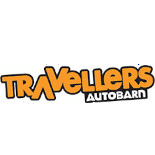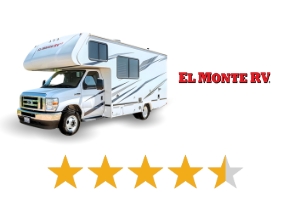

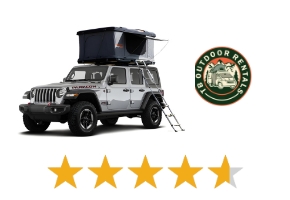
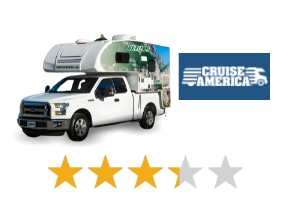
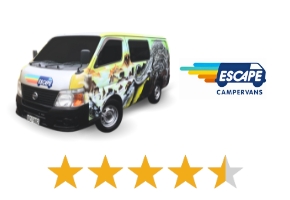
Camper Champ compares over a dozen RV rental brands across the USA.
Campervans are available across multiple destinations from the East Coast to West Coast, with one-way rental being a popular option.
RV travel in the US is more popular than ever, meaning there are tons of services and facilities catering to travellers. You’ll find scenic campgrounds in legendary national parks, private RV parks with top-notch facilities, and even some free overnight parking options for those on a tight budget.
Few countries can contend with the epic road trip lore of the US. From iconic routes like Highway 101 and Route 66 in the West to scenic byways across the Midwest and historic small towns in the East—this vast country offers unique experiences in spades.
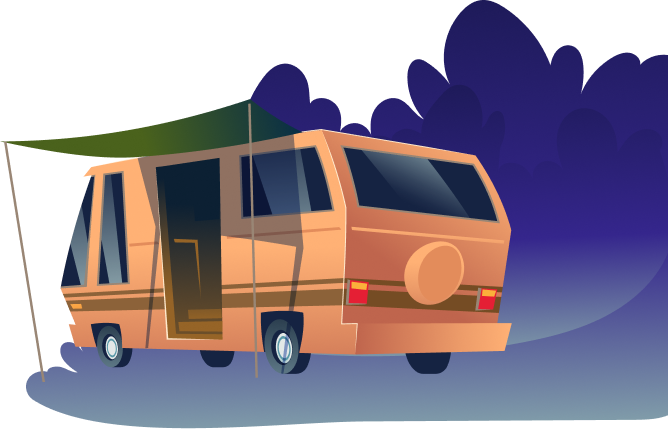
Discover the USA your way by choosing a class of RV that suits your travel needs.
Not all vehicles may be available. Use the search tool to check availability for your travel dates.
When it comes to hitting the open road in style, nothing beats the experience of journeying in an RV or Recreational Vehicle. These nomadic homes on wheels provide the unique fusion of travel and comfort, allowing you to explore the vast landscapes of the USA with the conveniences of home at your fingertips.
The world of RVs offers a rich array of options, each with its advantages and considerations. Your choice will depend on your budget, travel needs, the size of your travelling party, and your comfort preferences. Whether you're a solo adventurer looking for a compact camper or a family seeking a home away from home, there's an RV model class for you.
However, with the variety of RV classes available on the market, it can be overwhelming to identify the perfect fit for your travel needs. We’ve delved into the primary RV model classes and unravelled their unique features.
Think of these as the luxury yachts of the highway. Class A motorhomes are the largest and most luxurious RVs available, often ranging from 26 to 45 feet in length. They're built on specially designed motor vehicle chassis and resemble a bus in shape, with a flat or vertical front end and large windows. Amenities may include king-sized beds, full bathrooms, kitchen, living area, washer/dryer, and entertainment systems.
While Class A motorhomes offer unrivalled luxury and space, they also have a higher price tag and less fuel efficiency. Maneuvering them can be challenging for beginners, and you may encounter restrictions on where you can park due to their size.
Despite the 'B' in the name, these are the smallest motorhomes, also known as campervans. Class B RVs are built using standard van bodies, which manufacturers outfit with sleeping, kitchen, and bathroom facilities.
Class B motorhomes typically range between 18 to 24 feet long. They are easier to drive, park, and maintain, offering fuel efficiency. Although they lack the spaciousness of Class A and Class C motorhomes, modern designs and innovative features ensure they utilise their limited space exceptionally well.
A Class C motorhome is somewhat of a middle-ground option between the Class A and Class B motorhomes. They are built on a truck or van cutaway chassis with an attached cab section, distinguished by an over-cab sleeping area. The length can range from 20 to 33 feet.
These motorhomes offer more sleeping capacity than Class B motorhomes, and they often include similar amenities to those found in Class A models but on a smaller scale. They're easier to drive than a Class A and offer a good balance of luxury and maneuverability.
Travel trailers are towable RVs that come in a wide range of sizes, from tiny teardrop trailers to expansive two-story giants. These non-motorized RVs are designed to be towed by a car, SUV, minivan, or pickup truck via a bumper or frame hitch.
Travel trailers offer great versatility and can accommodate various travel needs and budgets. They're detachable, so you can use your vehicle for day trips or errands once you've set up camp. However, towing can be challenging, especially for first-time RVers.
The fifth-wheel trailers are the most spacious of the towable RVs, designed to be towed by a pickup truck using a special hitch in the truck bed. They offer many of the same amenities as Class A motorhomes, including slide-outs to increase living space.
The hitch's design allows for easier maneuverability while towing, making it more stable and safer on the road. On the flip side, you'll need a compatible truck and the necessary skills to handle the size and weight.
These compact units are designed to be loaded onto the bed of a pickup truck. Truck campers offer sufficient sleeping space, a small kitchenette, and usually a compact bathroom facility. The primary advantage of a truck camper is its mobility and compactness. They are perfect for adventurers who frequently travel off-the-beaten-path or in areas with tight spaces. With a truck camper, you can essentially camp anywhere your truck can go.
However, the living space in a truck camper is minimal, making them ideal for solo travellers or couples. While they don't provide the comfort of larger RVs, their flexibility and affordability make them a great choice for rugged, adventurous travel.
Pop-up campers, also known as fold-out campers or tent trailers, are a lightweight, affordable option perfect for novice RVers and camping enthusiasts. When in transit, these trailers are compact and streamlined. Once you reach your destination, they expand (either by cranking a handle manually or through an automatic system) to reveal sleeping areas and modest living spaces.
Some pop-up campers have basic amenities like a small kitchenette and a portable toilet. The main advantage of a pop-up camper is its ease of towing and storage. On the downside, they lack the insulation and amenities of larger RVs and may not be the best choice for colder climates or luxury-seeking travellers.
As the name suggests, hybrid trailers are a mix—in this case, a combination of a hard-sided travel trailer and a pop-up camper. They feature expandable tent sections, typically at the front, rear, or side of the trailer, providing extra sleeping quarters.
Hybrid trailers offer more living space than traditional pop-ups while maintaining a lightweight design that's easy to tow. They typically include more amenities than a pop-up camper but fewer than a traditional travel trailer. While the canvas sleeping areas allow for a more immersive nature experience, they offer less protection from the elements.
Park model RVs, also known as recreational park trailers, are unique in the world of RVs. They are designed to look like a home and are meant for seasonal use, typically in RV parks or campgrounds. While they're transportable, they're not meant for regular travel.
At around 400 square feet, park models offer plenty of living space, including full-size appliances and a comfortable bedroom, making them perfect for individuals or families who want to maintain the comforts of home while on the road.
Famed for its diversity and ever-changing scenery, the USA is the perfect place for a memorable motorhome holiday. There are endless perks to travelling the country by RV, with convenience and cost-effectiveness at the top of the list.
Affordable: When you combine your accommodation and transportation, you can save a lot of money. Travelling with a motorhome is one of the most affordable (and fun!) ways to see the US.
Convenient: The US is a massive country, with vast expanses nestled between its bigger metropolises. If you don’t want to be anchored to cities with an airport, you can hit the open road with your campervan and pick from a long list of campsites between destinations.
Flexibility: Traveling with a motorhome lets you leave a little wiggle room in your itinerary for those experiences you didn’t plan for. One of the best parts about a road trip is the hidden gems you find along the way!
Spend more time outdoors: There’s something special about setting up camp in the great outdoors. No 5-star hotel can compare to a crackling campfire at a scenic campsite!
On-board facilities: You can keep all your creature comforts close at hand when you travel with a motorhome. Everything you need is within reach, whether that be a cold beverage, a change of clothes, or a bathroom!
Remember these helpful tips when driving around the USA in an RV rental:
There are toll roads in most US states, though some regions have more than others. Florida, California, New York and New Jersey have many tolls, while some states like Tennessee, Arizona, and Wisconsin have none.
The good news is that most roll roads can be avoided by taking an alternative route. You’ll just need to do some advanced research and planning to avoid accidentally navigating the toll roads! This may add some time to your journey, but going off the beaten path is what motorhome holidays are all about!
Most toll roads allow drivers to pay by cash or credit card, though some routes use electronic transponders. Check with your rental company about their policy for toll roads.
Tip: You can use Google Maps to preview your route and see toll roads along the way. You can also filter results to avoid toll roads entirely.
The United States is a dream destination for a motorhome holiday. With world-famous national parks and landmarks, dramatic coastal drives, lush forests, stunning mountain routes, and beachside campsites, you won’t be left wanting. Unfortunately, it’s impossible to see it all and do it all in one single campervan holiday, so plan on discovering one region at a time.
The West Coast is one of the most popular road trips in the USA. Campervanners can amble from Seattle down to San Diego, stopping off in San Francisco, Los Angeles, and the countless charming seaside towns. There are plenty of beachside state parks and RV campgrounds along this route, and you’ll never tire of the gorgeous ocean scenery as you drive the iconic Highway 1 and 101.
This is a massive undertaking, so if you’re short on time, you should split the West Coast into smaller sections. Seattle to Portland is less than a four-hour drive, and a handful of national parks and beachside state parks are sprinkled between these two PNW icons. A shorter route also allows you to return your rental to the city you picked it up in, saving you some cash.
San Fransico to San Diego is another popular route for roadtrippers. As you cruise south along California’s spectacular Pacific Coast Highway(Highway 101), you’ll pass by dreamy redwood forests, towering mountain ranges, glorious wine regions, and the star-studded city of Los Angeles. There are also plenty of places to park your motorhome along the way, so take your time meandering along this incredible route.
On the other side of the country sits the equally impressive Northeast Coast. This region is known for its historic cities, sprawling mountain ranges, and coastal treasures like New York City and Acadia National Park. This area is much bigger than it looks on the map, so you’ll want to further divide this region into smaller sections to make it doable in a single trip.
Of course, NYC is an obvious choice and a great starting point for your Northeast motorhome holiday. But there’s a lot more to this sprawling state than just the Big Apple. Of course, spend some time exploring the city, pick up your hire and head out into the wilderness. Top highlights in New York State include Lake George and Lake Champlain straight north, the Finger Lakes Region and Niagara Falls to the northwest, and Long Island to the east.
For more great views from the driver's seat, pick up your campervan hire in Boston and make your way north into New Hampshire. The Kancamagus Highway runs through the White Mountain National Forest and is considered one of New England’s most scenic drives - especially when the fall foliage is in full swing. This beautiful route is everything you could want in a motorhome vacation, with historic sites, hiking trails, scenic lookout points, and RV-friendly campgrounds surrounding the highway.
Another great scenic drive close to Boston is the Massachusetts Coastline - specifically the Gloucester toRock Island stretch. This is about as Northeast as it gets, with pretty fishing villages, seafood shacks, and plenty of epic views along the way. This route will only take about an hour to complete, so it’s perfect for those short on time.
If it’s sunshine you’re seeking on your campervan holiday around the US, lock in an itinerary for the Southeast.
The sunny Southeast offers a wide range of diverse route options for campervanners. You could explore the Blue Ridge Mountains outside of Asheville, dive into some US history around Charleston or Savannah, or find yourself falling in love with country music in Nashville.
The cultural capital of the southeast, New Orleans, is also known for its beautiful architecture, lively nightlife, and culinary delights. While the city is known for its vibrant offerings, the swampy wilderness surrounding the Big Easy offers some great RV-friendly campgrounds and unique wildlife.
The campervanning lifestyle means something different to everyone, and those who prefer to sit back and relax while on holiday can park their bums on the white sand beaches of Florida. The sunshine state is extremely diverse, from the emerald green waters along the Panhandle (also known as the Redneck Riviera) to the lush wilderness of Ocala National Forest in central Florida, the quintessential white sand beaches surrounding the southern coastline, and the swampy wetlands of the Everglades. You could visit Florida repeatedly and never have the same experience twice.
Queue the tumbleweed rolling through a desert town vignette, and aim your compass for America’s Southwest.
This region is the stuff of legends and is the perfect place for a classic American road trip. There are many cool sites to see, but your experience will vary greatly depending on where you start your motorhome holiday. To experience the quintessential Southwest, you can pick up your rental in Las Vegas, then journey to some of the country's most famous national parks like Zion and the Grand Canyon, and more before hopping on Route 66 back to Sin City.
If you’re more interested in the mountains, start your holiday in Denver or Salt Lake City. Alternatively, a road trip around Texas will allow you to explore the cowboy culture in Dallas before venturing into the wilderness of the many national forests outside the city. The Southwest also comprises parts of southern California like Los Angeles and San Diego, which could be worked into an itinerary with Las Vegas or Phoenix or explored on their own if you’re short on time.
The Midwest is easily the most overlooked region in the US. If you want to travel far from the beaten path on your motorhome holiday, this is the area to look to.
You can start your journey in Chicago and then explore the unspoiled nature surrounding the Great Lakes in Wisconsin, Minnesota or Michigan.
There are also a few interesting sites in the Dakotas, including Mount Rushmore and Badlands National Park in South Dakota. In North Dakota, you can follow the trail of Lewis and Clarke through the glorious Missouri River Valley and trek along the scenic Highway 83, making a detour to spot the bison herds in Theodore Roosevelt National Park.
A stay at an RV park will usually cost around $25–80 (USD) per night.
The cost of campgrounds has risen in recent years due to the popularity of RV vacations in the USA.
While free camping is only allowed in designated areas throughout the USA, there are plenty of locations in which you can do this.
Both the US Forest Service and Bureau of Land Management care for millions of acres of land where free camping is allowed.
Many retailers and casinos may also allow you to camp for a night in their parking lot with permission from the owner.
There are also truck stops and rest stops where you can pull up for a night, many of which have facilities included.
The majority of campervan rental suppliers in the US do not offer unlimited miles as a standard rental inclusion.
In most cases, miles (kilometres) are capped at a daily rate, and additional fees will be incurred if you exceed the limit. Additional miles can usually also be prepurchased in packages ranging from 100 miles up to unlimited. However, any remaining miles will not be refunded when the vehicle is returned.
Check our comparison tool for details.
A wide variety of motorhomes are available in the USA, from smaller station wagons up to large motorhomes. Some of the common types include:
Class A motorhomes are often built on a commercial truck or bus chassis and run on either diesel or gas, depending on the type of engine.
Usually, Class A vehicles are fully loaded with all amenities and have a large living space.
Some Class B vehicles include a toilet or freshwater tank, but not all do. Class B vehicles usually have basic cooking equipment, folding beds and limited storage space.
Class B vehicles are a good option for short-term getaways.
Class C vehicles are a smaller version of the Class A motorhome. They are built on a truck or van cutaway chassis and usually have a gas-powered engine.
Class C motorhomes generally have sleeping quarters above the cab and more sleeping space in the back. Some Class Cs also have a slide-out option that increases the living space when the motorhome is parked.
Class C vehicles come equipped with a good number of facilities, including a self-contained toilet, refrigerator, heating or AC, and cooking facilities.
Class C vehicles are very versatile and are great for both short- and long-term getaways.
Our comparison tool will show you the specifications of each vehicle available to help you find a camper suitable for your needs.
All drivers must have a current and full driver’s licence to hire a vehicle. Foreign licences are generally acceptable if they are in English or accompanied by an accredited English translation. Otherwise, an International Driving Permit (IDP) is required.
In addition to your driver’s licence, you will often be required to show your passport at the time of pickup.
Some companies, e.g. Road Bear, Best Time and Britz, require an IDP regardless of the language of your licence.
This depends on the company. Several rental suppliers will allow you to travel to Canada in your rental vehicle, including Apollo, El Monte, Jucy, Campervan North America, Travellers Autobarn, Escape Rentals and Cruise America.
Please contact support for information on other suppliers. You must comply with visa and customs requirements at all times.
Note: policies vary from supplier to supplier. Always check the T&Cs for your rental.












